Scientific name: Coccoloba uvifera
Other common names: Mangrove grape, platterleaf, Jamaican kino, shore grape, bay grape
Spanish: Uva caleta, Uva de playa, Uvero, Uvero de playa
French: Cipo Branco De Pernambuco, Kino, Raisin MarinePortuguese: Cocoloba, Uva-da-praia, Uva-do-mar
Identification
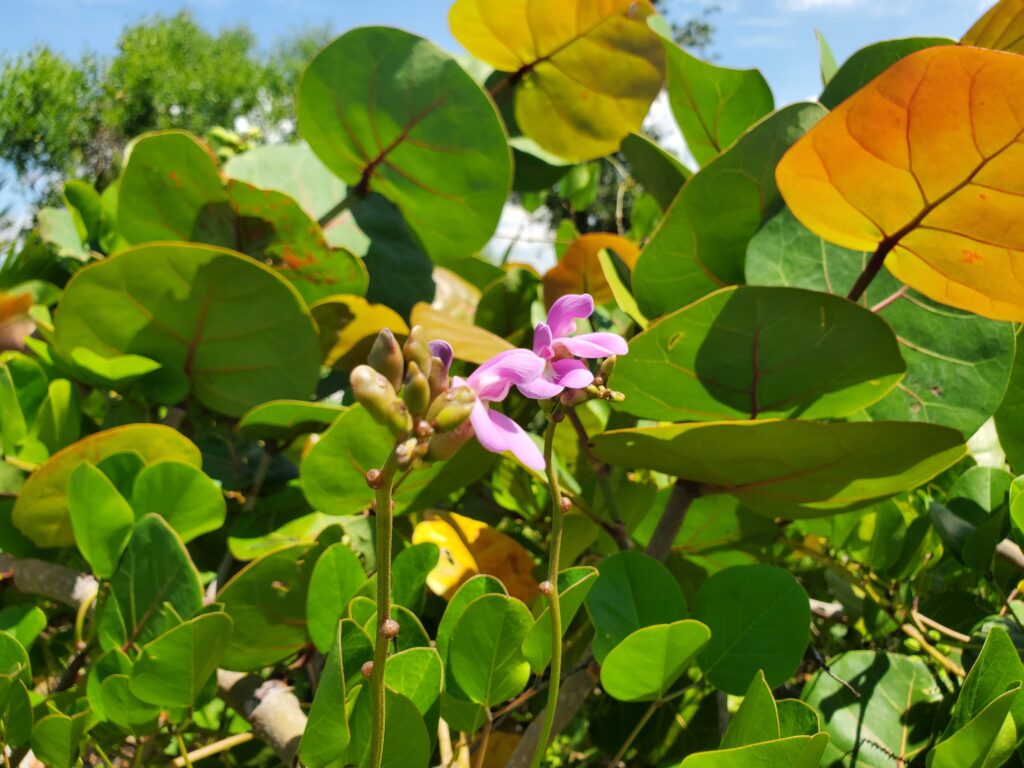
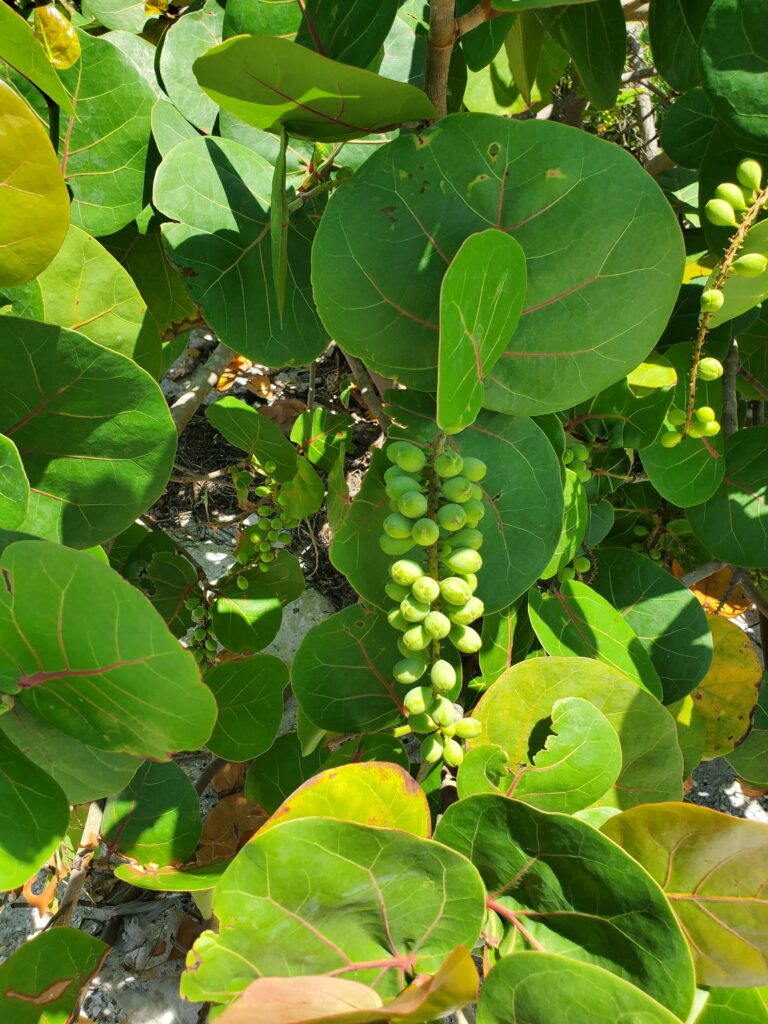
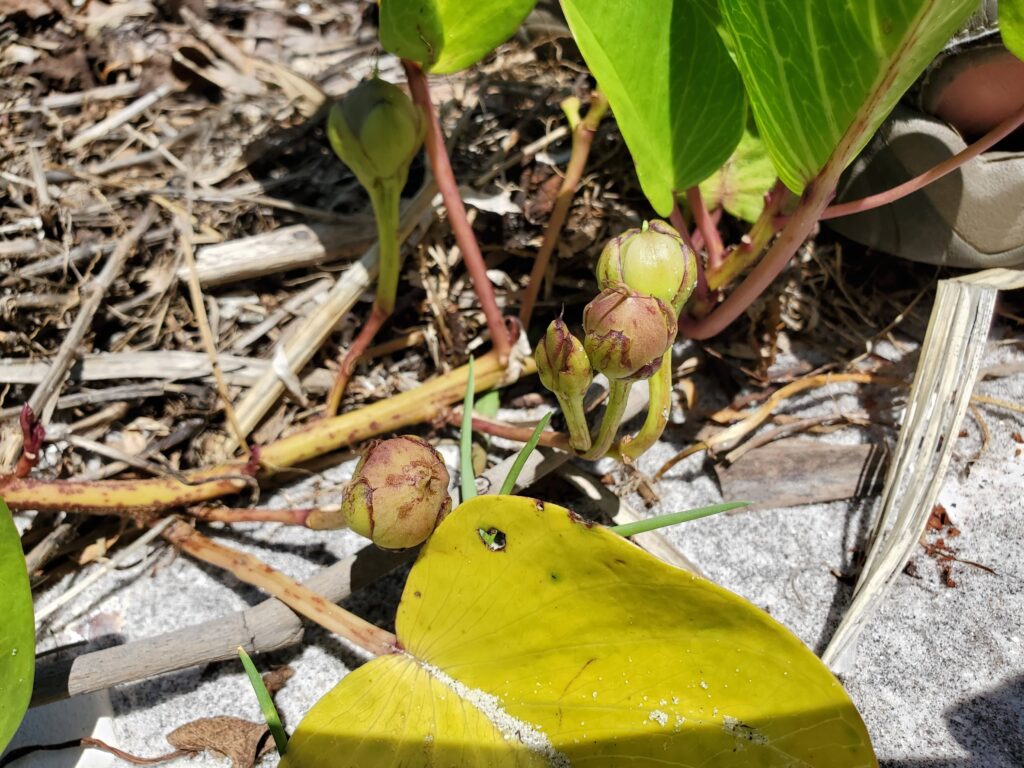
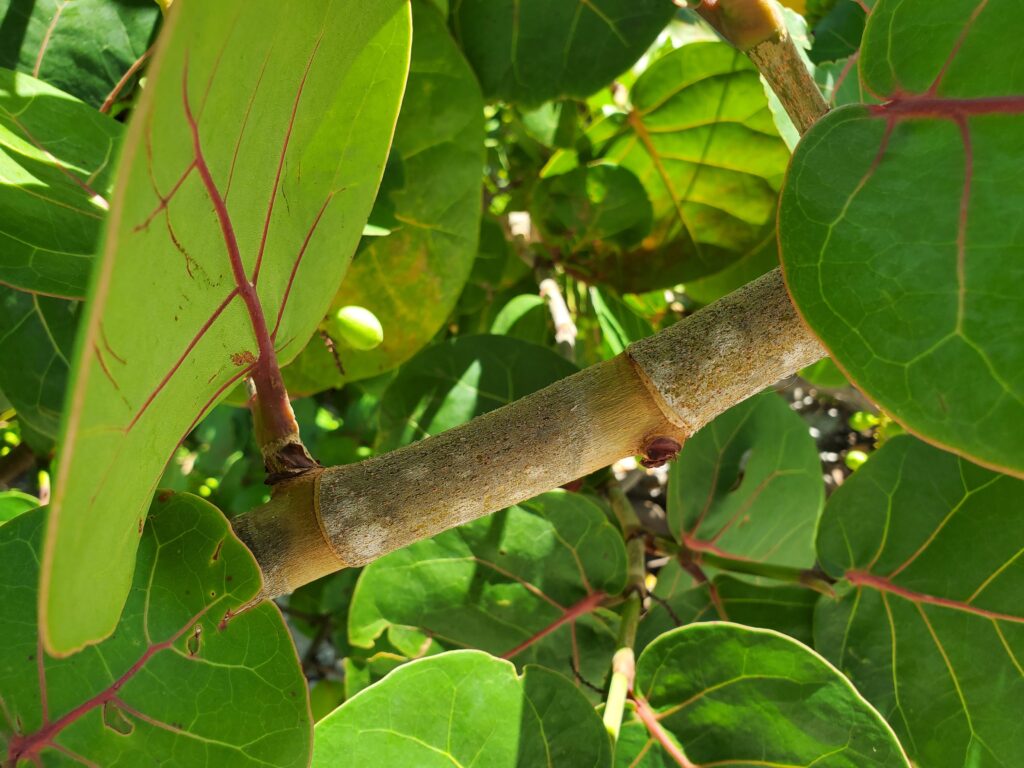
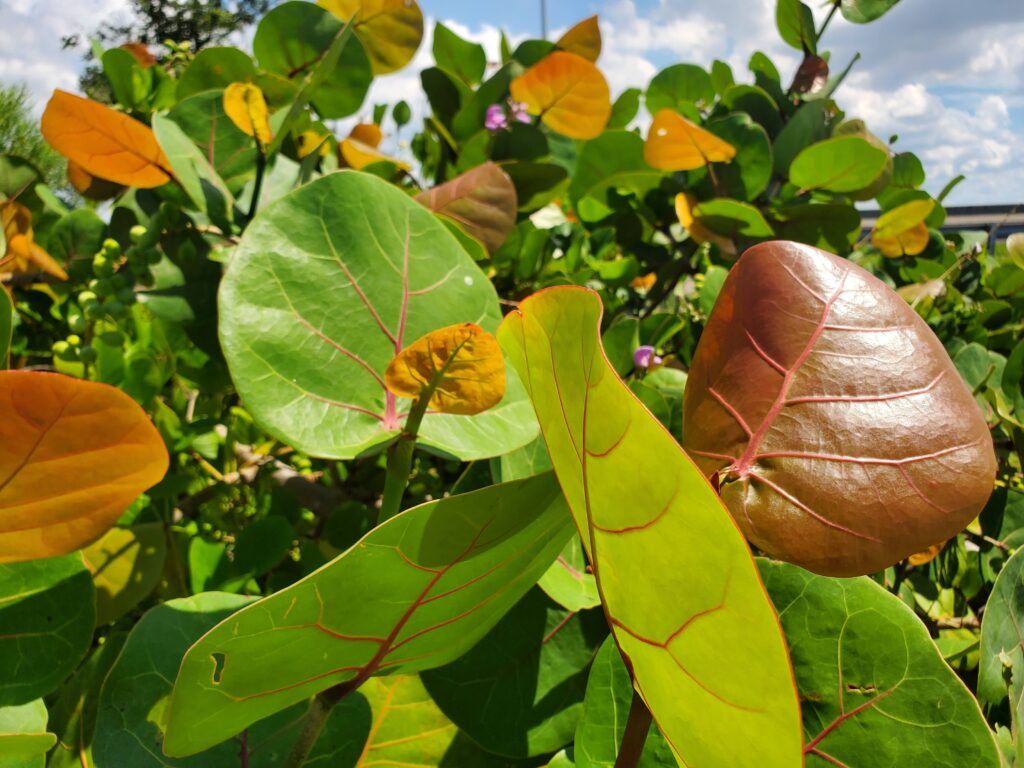
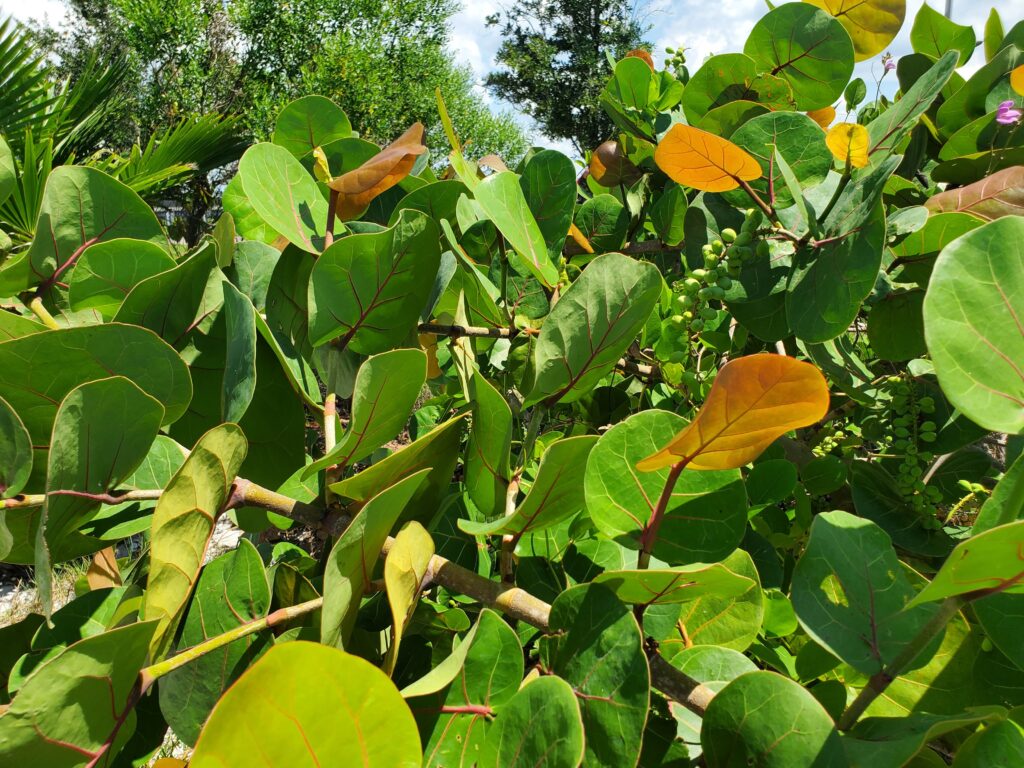
Sea grapes can range in size from a small bush to a full size tree. In ideal conditions, it can grow up to 40 or 50 feet high but in Florida they are usually less than 15 feet in height and keep a bush-like shape. The bark is smooth and a yellow-brown color. 1
The leaves are large, up to seven inches, roundish or bean shaped, with wavy edges and a striking reddish central vein. They feel leathery to the touch and appear waxy.
The flowers are small, off white and grow in clusters that look like spikes.
The marble sized fruit grows in bunches similar to grapes but skinnier, with all the fruit clustered around one central stem. The green fruit typically appears in late summer and turns pinkish-purple when ripe. Due to the effects of climate change, fruit can be spotted as early as May in Florida.
Growing/Foraging
Sea grapes are native to beaches throughout tropical America and the Caribbean. They are also grown as an ornamental tree in South and Central Florida.2 Even though they tolerate salty soil and air, they will also grow well in rich soil. 3 They fare well in full sun or partial shade but are frost sensitive according to the University of Florida Institute of Food and Agricultural Sciences Extension Office.
Sea grapes are a protected plant in Florida. Florida statute 161.242 prohibits harvesting sea grapes from public property. It’s okay to harvest sea grapes from private property, with the owner’s permission of course.
Sea grapes don’t need salty soil to thrive. If you live in a region that doesn’t freeze in the winter, consider growing your own. They can be grown from seeds or from cuttings. The seeds don’t store for long so should be planted immediately. They are said to be excellent bonsai candidates. Sea grape is a dioecious tree, meaning you need a male and a female in the same area for the female to produce fruit. If you grow them from seed, plant three or more to ensure you have at least one of each. 4
Sustainability
Sea grape is one of the largest of a limited variety of native plants that tolerate and thrive in salty soil and air. Because of this it’s an important sea dune stabilization plant. It’s roots keep sand in place and prevent the erosion of the beach from the tides and storms. Be very careful when harvesting Sea grapes that are near the ocean or other bodies of water, only take from well established plants that are part of a large group. Don’t take more than a third of the available fruit and even fewer of the leaves. The leaves are potent medicine and you shouldn’t need many anyway.
Medicinal and Food Properties
As a traditional medicine in the Caribbean and South America, tea made from the leaves is used to treat intestinal issues such as diarrhea and dysentery, as well as sore throat and asthma. A decoction of the leaves is astringent and has been traditionally used on the skin to relieve irritation caused by rashes and wounds.56
A patent filing from 1999 suggests drinking tea made with the leaves reduces blood sugar. Though drinking too much can make your blood sugar too low, especially if taken with medications made to do the same thing. The beneficial compounds in the leaves are resistant to both high heat and stomach acids, making them an ideal remedy for high blood sugar that can be taken by mouth.78
The leaves have antifungal and antibacterial properties. Studies have shown a strong tea made with sea grape leaves used topically, on the surface of an object or the skin, will slow or prevent the growth of many common bacteria and funguses. 9
The ripe fruits are packed full of nutrients and antioxidants and can be eaten raw or made into wine or jelly.10
The tree attracts pollinators including bees. The resulting honey is especially sweet and slightly spicy. 11
Safety
Be wary if you have diabetes and are on medication for it. Sea grape’s glucose lowering properties may lower your blood sugar to an unsafe level.
Recipes
Sea Grape Leaf Decoction
The patent claiming this plant’s effectiveness at lowering blood sugar level gives an ideal way to prepare a decoction of the leaves to get the most beneficial compounds. The compounds in the leaves are resistant to high heat. That means boiling for long periods of time will not ruin the decoction’s medicinal benefits like it would for many other herbs. 12
- Add 4 green leaves to one gallon (3.8 liters) of water
- Bring it to a boil for 4 hours
- Remove the leaves and store it refrigerated in an airtight container
- Monitor your glucose level while drinking this tea to avoid it dropping too low
Sea Grape Jelly
This is a classic recipe to make jelly that can be canned and stored. It makes a lot of jelly and requires the right supplies and canning jars.
Ingredients
- 8 cups of ripe (pink or purple) sea grapes
- 4 cups of water
- 5 cups of sugar
- 1 box (1.75 oz.) of Sure Jell pectin
- 2 limes (1/4 cup of lime juice)
- ½ teaspoon butter
Equipment
- 8 8oz canning jars
- Potato masher or a large fork
- Large stainless steel pot
- Canning pot and other tools
- large colander
- cheesecloth
Instructions
- Rinse the sea grapes in a colander. Remove any that are unripe.
- In the stainless steel pot, cover the grapes with water. Cook on medium heat for 75 minutes until the seeds break away from the fruit and the fruit softens.
- Use a potato masher to further loosen the fruit.
- Cut two strips of cheesecloth and spread over a colander that should be sitting on top of a bowl to collect the juice. Then, place the cooked grapes into the cheesecloth,close the cheesecloth to form a large tight ball. Squeeze the juice out of the pulp into the bowl.
- Add water to the juice to make 5 cups total.
- Return the juice to the pot. Add Sure Jell, butter, lime juice and bring to a rolling boil. Slowly add five cups of sugar, stirring. Bring the mixture to another boil for 1 minute.
- Pour the jelly mixture into the sterilized canning jars and seal tightly. Let it thicken overnight.
Sources

